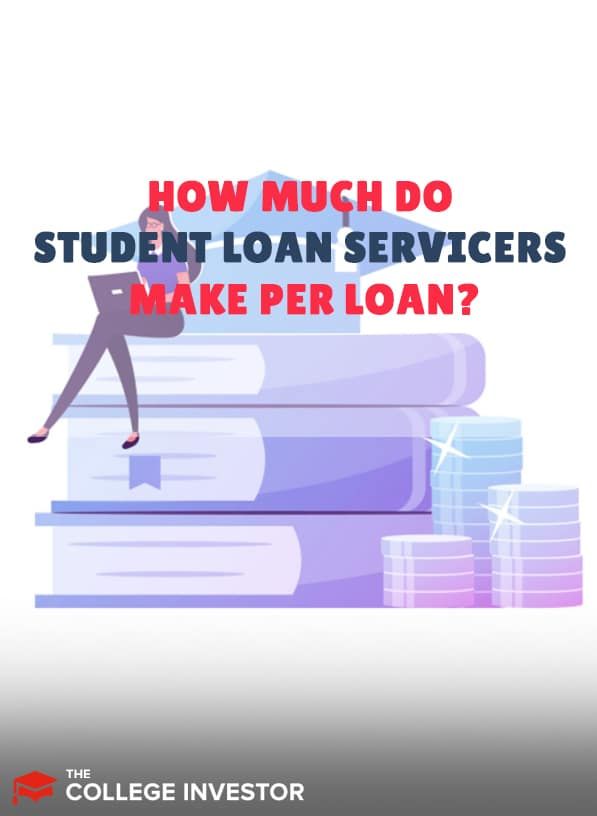
Borrowers often believe that student loan servicers get to keep the interest on the loan. But it doesn’t work like that.
Servicing companies collect payments of principal and interest on behalf of the loan holder (the Department of Education in the case of federal loans). In exchange, they're paid a monthly fee for each loan serviced.
So how much do federal student loan servicers make per loan? Below, we explain how their fees are determined and how that can impact the customer service and advice they offer.
How Loan Servicing Fees Are Determined
There are two approaches to specifying how much federal student loan servicers make per loan. These are:
- Percentage basis — A small percentage of the outstanding loan balance
- Unit cost basis — A fixed dollar amount
Originally, federal loan servicers like Fedloan and Nelnet were paid a fixed percentage of the outstanding loan balance per year. 90 bp (0.90%) was typical. Since this fee is based on the loan balance, it would decrease as the loan was repaid.
Today, servicers are paid a fixed dollar amount per loan each month, regardless of the loan balance. The amount of the flat fee varies, depending on whether the loan is current or delinquent.
Unit Cost Basis
Table #1, below, shows how much federal student loan servicers make each month. (The third column shows the annualized amount.) This table is based on the 2014 contracts for: Navient, Great Lakes, Nelnet, and PHEAA (Fedloan Servicing).
Typically, a contract is good for five years, but may be extended by the U.S. Department of Education.
Loan Status | Monthly Amount | Annualized Amount |
|---|---|---|
In School | $1.05 | $12.60 |
Grace Period | $1.68 | $20.16 |
In Repayment | $2.85 | $34.20 |
Deferment | $1.68 | $20.16 |
Forbearance | $1.05 | $12.60 |
Delinquent (6-30 Days) | $2.11 | $25.32 |
Delinquent (31-90 Days) | $1.46 | $17.52 |
Delinquent (91-150 Days) | $1.35 | $16.20 |
Delinquent (151-270 Days) | $1.23 | $14.76 |
Delinquent (270+ Days) | $0.45 | $5.40 |
The loan servicers are also paid $27.35 per consolidation. When a loan is consolidated, the loan servicing usually is assigned to a different loan servicer. These servicing fees are somewhat different than in the 2009 contract, which as shown below in Table #2.
Loan Status | Monthly Amount | Annualized Amount |
|---|---|---|
In School | $1.05 | $12.60 |
Grace Period | $2.11 | $25.32 |
In Repayment | $2.11 | $25.32 |
Deferment | $2.07 | $24.84 |
Forbearance | $2.07 | $24.84 |
Delinquent (31-90 Days) | $1.62 | $19.44 |
Delinquent (91-150 Days) | $1.50 | $18.00 |
Delinquent (151-270 Days) | $1.37 | $16.44 |
Delinquent (270+ Days) | $0.50 | $6.00 |
The fees for borrowers in repayment were capped at 3 million borrowers. Beyond that limit, the fees were $1.90 per borrower per month. Similarly, the fees for borrowers in forbearance were capped at 1.6 million borrowers. Beyond that limit, the fees were $1.73 per borrower per month.
The 2011 contract for the not-for-profit loan servicers, which was last updated in 2019, have slightly higher fees, as shown in Table #3 below.
Loan Status | Monthly Amount | Annualized Amount |
|---|---|---|
In School | $1.15 | $13.80 |
Grace Period | $2.32 | $27.84 |
In Repayment | $2.32 | $27.84 |
Deferment | $2.28 | $27.36 |
Forbearance | $2.28 | $27.36 |
Delinquent (31-90 Days) | $1.78 | $21.36 |
Delinquent (91-150 Days) | $1.65 | $19.80 |
Delinquent (151-270 Days) | $1.51 | $18.12 |
Delinquent (270+ Days) | $0.55 | $6.60 |
Consequences Of The Fee Schedule
If a borrower is current for the entire duration of a 10-year repayment plan, the loan servicer will receive $342.00 over the repayment term, plus $47.25 for the in-school period and $10.08 for the grace period. That’s a total of $399.33 per borrower.
If the borrower is current for the entire duration of a 25-year repayment plan, the loan servicer will receive $855.00 over the repayment term, plus $47.25 for the in-school period and $10.08 for the grace period. That’s a total of $912.33 per borrower.
Customer Service
But how much do federal student loan servicers make if the borrower is late with a payment or in a deferment or forbearance? In that case, they get paid a lot less, potentially as little as $54.00 over a 10-year repayment term.
If a borrower is 271 or more days delinquent, the $0.45 servicing fee is not enough to cover the cost of a 5-minute call to the borrower or the postage for a letter to the borrower.
This is why loan servicers use a lot of automation. It also means that the servicing fees for borrowers who are current subsidize the cost of servicing the borrowers who are delinquent.
Repayment Recommendations
Some borrower advocates have argued that there is an incentive for loan servicers to push forbearances over Income-Driven Repayment (IDR) since it takes less time to explain a forbearance. That idea may have certainly had merit in the past. In the 2011 contract, for example, you'll notice that servicers only received four cents more for loans "in repayment" than those in forbearance.
But under the most recent fee structure (shown in Table #1 above), a for-profit loan servicer earns more than 2.5 times as much per month from a borrower in an IDR plan. In fact, the current fee schedule pays more for almost every loan status than for a loan in forbearance (with the only exception being a borrower who is 270+ days delinquent).
The fee structure also provides loan servicers with a financial incentive to help borrowers who are delinquent back into good standing, since they get paid more for a borrower who is current than for a borrower who is delinquent.
Final Thoughts
Loan servicers have a financial incentive to keep as many borrowers current as possible and to keep telephone calls as short as possible.
Loan servicers also have a financial incentive to keep borrowers in repayment for as long as possible. They'll earn more from a borrower who is in an extended repayment plan than from a borrower who is in a standard repayment plan. They earn the same monthly fee, but they earn it over a longer period of time.

Mark Kantrowitz is an expert on student financial aid, scholarships, 529 plans, and student loans. He has been quoted in more than 10,000 newspaper and magazine articles about college admissions and financial aid. Mark has written for the New York Times, Wall Street Journal, Washington Post, Reuters, USA Today, MarketWatch, Money Magazine, Forbes, Newsweek, and Time. You can find his work on Student Aid Policy here.
Mark is the author of five bestselling books about scholarships and financial aid and holds seven patents. Mark serves on the editorial board of the Journal of Student Financial Aid, the editorial advisory board of Bottom Line/Personal, and is a member of the board of trustees of the Center for Excellence in Education. He previously served as a member of the board of directors of the National Scholarship Providers Association. Mark has two Bachelor’s degrees in mathematics and philosophy from the Massachusetts Institute of Technology (MIT) and a Master’s degree in computer science from Carnegie Mellon University (CMU).
Editor: Robert Farrington Reviewed by: Clint Proctor
